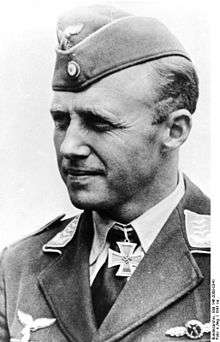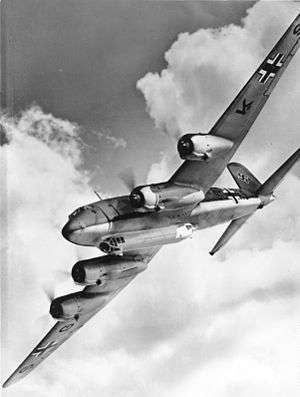Fritz Fliegel
| Fritz Fliegel | |
|---|---|
 | |
| Born |
30 November 1907 Wilmersdorf, Berlin |
| Died |
18 July 1941 (aged 33) Atlantic Ocean |
| Allegiance |
|
| Service/branch |
|
| Rank | Hauptmann (captain) |
| Commands held | I./KG 40 |
| Battles/wars | |
| Awards | Knight's Cross of the Iron Cross |
Fritz Fliegel (30 November 1907 – 18 July 1941) was a German Luftwaffe bomber pilot and recipient of the Knight's Cross of the Iron Cross during World War II. The Knight's Cross of the Iron Cross was awarded to recognise extreme battlefield bravery or successful military leadership. On 18 July 1941, Fiegel was killed in action flying a Focke-Wulf Fw 200 during the Battle of the Atlantic in an attack on convoy OB 346. He targeted the 7,046-ton freighter Pilar de Larrinaga. However, the gunners shot his starboard wing off and he crashed into the sea, killing all on board.
Early life and career
Fliegel was born on 30 November 1907 in Wilmersdorf, a borough of Berlin, in the Kingdom of Prussia. In 1934, he transferred from the infantry of the Reichsheer (Army) to the newly emerging Luftwaffe (Air Force) of the Third Reich. Following his flight training, he served as flight instructor at the pilot schools A/B 42 in Salzwedel and A/B 113 in Brünn.[Note 1] There he was promoted to Hauptmann (captain) on 1 March 1939.[2]
World War II
World War II in Europe began on Friday, 1 September 1939, when German forces invaded Poland. Fliegel flew combat missions over Poland and received the Iron Cross 2nd Class (Eisernes Kreuz 2. Klasse) on 15 September 1939. In early May 1940 when I. Gruppe (1st group) of Kampfgeschwader 40 (KG 40—40th Bomber Wing), a unit equipped with the long-range Focke-Wulf Fw 200 "Condor" reconnaissance and anti-shipping/maritime patrol bomber aircraft, Fliegel was transferred to the 2. Staffel (2nd squadron) of KG 40.[Note 2] The unit initially operated against enemy shipping from airbases in Denmark. There he was awarded the Iron Cross 1st Class (Eisernes Kreuz 1. Klasse) on 13 May 1940.[2]

In mid-1940, I. Gruppe relocated to the airbase Bordeaux-Mérignac at the Atlantic coast near Bordeaux in France. In October 1940, he was appointed Staffelkapitän (squadron leader) of 2. Staffel of KG 40. Flying the Fw 200 to its maximum range, I. Gruppe was credited with the destruction of 39 enemy merchant ships totaling 206,000 gross register tons (GRT), further damaging 20 ships of 115,000 GRT.[2]
On 6 February 1941, U-37 under the command of Kapitänleutnant (Captain Lieutenant) Nicolai Clausen, spotted convoy HG 53, 19 merchant ships escorted by HMS Velox and Deptford, heading for Liverpool. Clausen reported the sighting, which was relayed to KG 40 by Fliegerführer Atlantik. On 9 February, KG 40 sent five Fw 200s to attack the convoy which was spotted at 4 pm roughly 640 kilometers (400 miles; 350 nautical miles) southwest of Lisbon. In the attack at 35°42′N 14°38′W / 35.700°N 14.633°W, the Fw 200's managed to sink five ships (Britannic, Dagmar I, Jura, Tejo and Varna), and Deptford damaged the Fw 200 piloted by Oberleutnant (First Lieutenant) Erich Adam, who managed to fly his aircraft to Spain. U-37 sank three further ships from HG 53.[3][4] This achievement earned him his first mention in the Wehrmachtbericht, an information bulletin issued by the headquarters of the Wehrmacht.[2]
Fliegel was awarded the Knight's Cross of the Iron Cross (Ritterkreuz des Eisernen Kreuzes) on 25 March 1941. In mid-April 1941 he was appointed Gruppenkommandeur (group commander) of I. Gruppe of KG 40, replacing Major Edgar Petersen. He was mentioned a second time in the Wehrmachtbericht on 20 June 1941 after the number of enemy shipping destroyed by his Gruppe increased by a further 24 ships, reaching 109 enemy ships sunk.[2] By early 1941 I. Gruppe of KG 40 had five holders of the Knight's Cross of the Iron Cross reflecting the success of the Condors in Atlantic Ocean operations.[5]
Killed in action
On 18 July 1941, Fliegel and his crew—copilot Leutnant (Second Lieutenant) Wolf-Dietrich Kadelke, first radio operator Oberfeldwebel (Staff Sergeant) Johannes Rottke, second radio operator Gefreiter (Airman) Karl Becker, flight engineer Unteroffizier (Sergeant) Johann Kothe and air gunner Unteroffizier Karl Meurer—were reported missing in action over the Atlantic in the vicinity northwest of Ireland.[2] Their Fw 200 C-3 "F8+AB" (Werknummer 0043—factory number) was shot down in an attack on convoy OB 346. During the attack on the freighter Pilar de Larrinaga, the gunners on board the freighter scored a hit on the Fw 200's starboard wing which tore it off.[6]
Awards
- Iron Cross (1939)
- Knight's Cross of the Iron Cross on 25 March 1941 as Hauptmann and Gruppenkommandeur of the I./Kampfgeschwader 40[7]
- Mentioned twice in Wehrmachtbericht (10 February 1941 and 20 June 1941)
Notes
- ↑ Flight training in the Luftwaffe progressed through the levels A1, A2 and B1, B2, referred to as A/B flight training. A training included theoretical and practical training in aerobatics, navigation, long-distance flights and dead-stick landings. The B courses included high-altitude flights, instrument flights, night landings and training to handle the aircraft in difficult situations.[1]
- ↑ For an explanation of Luftwaffe unit designations see Organization of the Luftwaffe during World War II.
References
Citations
Bibliography
- Bergström, Christer; Antipov, Vlad; Sundin, Claes (2003). Graf & Grislawski – A Pair of Aces. Hamilton MT: Eagle Editions. ISBN 978-0-9721060-4-7.
- Bertke, Donald A; Smith, Gordon; Kindell, Don (2009). World War II Sea War, Volume 3: The Royal Navy is Bloodied in the Mediterranean. Dayton, Ohio: Bertke Publisher. ISBN 978-1-937470-01-2.
- Forczyk, Robert (2010). Fw 200 Condor Vs Atlantic Convoy, 1941–43. Oxford; Long Island City, NY:: Osprey Publishing. ISBN 978-1-84603-917-1.
- Goss, Chris (2005). Sea Eagles. Vol. 1: Luftwaffe Anti-Shipping Units, 1939–41. Hersham: Classic Publication. ISBN 978-1-903223-55-0.
- Kaiser, Jochen (2010). Die Ritterkreuzträger der Kampfflieger—Band 1 [The Knight's Cross Bearers of the Bomber Flyer—Volume 1] (in German and English). Bad Zwischenahn, Germany: Luftfahrtverlag-Start. ISBN 978-3-941437-07-4.
- McNab, Chris (2012). Hitler's Eagles: The Luftwaffe 1933–45. Oxford; Long Island City, NY: Osprey Publishing. ISBN 978-1-78096-283-2.
- Scherzer, Veit (2007). Die Ritterkreuzträger 1939–1945 Die Inhaber des Ritterkreuzes des Eisernen Kreuzes 1939 von Heer, Luftwaffe, Kriegsmarine, Waffen-SS, Volkssturm sowie mit Deutschland verbündeter Streitkräfte nach den Unterlagen des Bundesarchives [The Knight's Cross Bearers 1939–1945 The Holders of the Knight's Cross of the Iron Cross 1939 by Army, Air Force, Navy, Waffen-SS, Volkssturm and Allied Forces with Germany According to the Documents of the Federal Archives] (in German). Jena, Germany: Scherzers Militaer-Verlag. ISBN 978-3-938845-17-2.
- Die Wehrmachtberichte 1939–1945 Band 1, 1. September 1939 bis 31. Dezember 1941 [The Wehrmacht Reports 1939–1945 Volume 1, 1 September 1939 to 31 December 1941] (in German). München, Germany: Deutscher Taschenbuch Verlag GmbH & Co. KG. 1985. ISBN 978-3-423-05944-2.